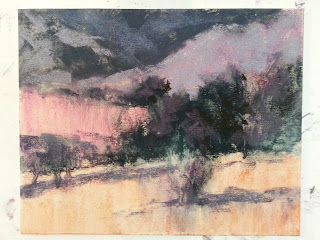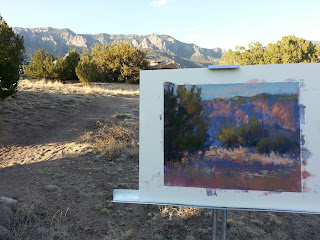 |
| As Evening Takes Shape, pastel, 8x10 |
With southwest scenery still rolling around in my head from my recent visit to New Mexico, my students were stuck painting the desert again this week. They didn't seem to mind this week either. I think we all agreed...it's a gorgeous part of the country.
For this week's exercise, I thought we'd take the sky out of the mix and crop into the landscape to create some bigger shapes. Not that the southwest doesn't have some amazing skies to paint, but this particular landscape already had some great shapes happening, and I thought the tighter crop would highlight this and make for a more intimate view. However the sky from above is still speaking loud and clear by how its reflected within the landscape elements.
Regarding color palette for this one, I noticed a striking difference in colors (both when painting there on location and from my photos) when the sun got just a little lower in the sky, and also where the sun hit the landscape directly vs. indirectly. Compared to last week's class demo, the photo used for this scene (in the same general location as last week's) was taken just a little earlier in the evening. Last week's was a little later in the evening and was also a view that was catching the setting sun more directly, providing a much warmer color palette chock full of oranges and pinks. Whereas this view caught the sun coming from the left side and not quite as low (or golden) in the sky, providing a more cooler and subdued color palette. Amazing how the angle and direction of the sunlight can affect color so much!
In an initial thumbnail value sketch, I worked out the division of space and angles of these large shapes, connecting similar value shapes wherever possible.* My initial block-in was done from the value sketch (not the photo). Below are some progression shots of my demo, starting with the block-in using about 6 pastels (Nupastels and Rembrandts) then washed down with alcohol and a bristle brush. As I progressed, I added details in "large chunks" before deciding toward the end what few details needed to be even smaller, and continually checked my values for accuracy.
*I teach my process for working with thumbnail value sketches more thoroughly in my workshops. See my website (www.barbarajaenicke.com) if you're interested in taking one of my workshops.
























